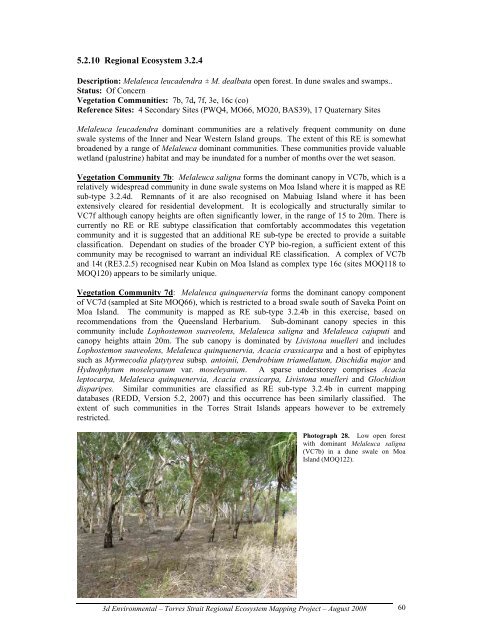Appendix 2 - Vegetation Communities and Regional Ecosystems
Appendix 2 - Vegetation Communities and Regional Ecosystems
Appendix 2 - Vegetation Communities and Regional Ecosystems
You also want an ePaper? Increase the reach of your titles
YUMPU automatically turns print PDFs into web optimized ePapers that Google loves.
5.2.10 <strong>Regional</strong> Ecosystem 3.2.4<br />
Description: Melaleuca leucadendra ± M. dealbata open forest. In dune swales <strong>and</strong> swamps..<br />
Status: Of Concern<br />
<strong>Vegetation</strong> <strong>Communities</strong>: 7b, 7d, 7f, 3e, 16c (co)<br />
Reference Sites: 4 Secondary Sites (PWQ4, MO66, MO20, BAS39), 17 Quaternary Sites<br />
Melaleuca leucadendra dominant communities are a relatively frequent community on dune<br />
swale systems of the Inner <strong>and</strong> Near Western Isl<strong>and</strong> groups. The extent of this RE is somewhat<br />
broadened by a range of Melaleuca dominant communities. These communities provide valuable<br />
wetl<strong>and</strong> (palustrine) habitat <strong>and</strong> may be inundated for a number of months over the wet season.<br />
<strong>Vegetation</strong> Community 7b: Melaleuca saligna forms the dominant canopy in VC7b, which is a<br />
relatively widespread community in dune swale systems on Moa Isl<strong>and</strong> where it is mapped as RE<br />
sub-type 3.2.4d. Remnants of it are also recognised on Mabuiag Isl<strong>and</strong> where it has been<br />
extensively cleared for residential development. It is ecologically <strong>and</strong> structurally similar to<br />
VC7f although canopy heights are often significantly lower, in the range of 15 to 20m. There is<br />
currently no RE or RE subtype classification that comfortably accommodates this vegetation<br />
community <strong>and</strong> it is suggested that an additional RE sub-type be erected to provide a suitable<br />
classification. Dependant on studies of the broader CYP bio-region, a sufficient extent of this<br />
community may be recognised to warrant an individual RE classification. A complex of VC7b<br />
<strong>and</strong> 14t (RE3.2.5) recognised near Kubin on Moa Isl<strong>and</strong> as complex type 16c (sites MOQ118 to<br />
MOQ120) appears to be similarly unique.<br />
<strong>Vegetation</strong> Community 7d: Melaleuca quinquenervia forms the dominant canopy component<br />
of VC7d (sampled at Site MOQ66), which is restricted to a broad swale south of Saveka Point on<br />
Moa Isl<strong>and</strong>. The community is mapped as RE sub-type 3.2.4b in this exercise, based on<br />
recommendations from the Queensl<strong>and</strong> Herbarium. Sub-dominant canopy species in this<br />
community include Lophostemon suaveolens, Melaleuca saligna <strong>and</strong> Melaleuca cajuputi <strong>and</strong><br />
canopy heights attain 20m. The sub canopy is dominated by Livistona muelleri <strong>and</strong> includes<br />
Lophostemon suaveolens, Melaleuca quinquenervia, Acacia crassicarpa <strong>and</strong> a host of epiphytes<br />
such as Myrmecodia platytyrea subsp. antoinii, Dendrobium triamellatum, Dischidia major <strong>and</strong><br />
Hydnophytum moseleyanum var. moseleyanum. A sparse understorey comprises Acacia<br />
leptocarpa, Melaleuca quinquenervia, Acacia crassicarpa, Livistona muelleri <strong>and</strong> Glochidion<br />
disparipes. Similar communities are classified as RE sub-type 3.2.4b in current mapping<br />
databases (REDD, Version 5.2, 2007) <strong>and</strong> this occurrence has been similarly classified. The<br />
extent of such communities in the Torres Strait Isl<strong>and</strong>s appears however to be extremely<br />
restricted.<br />
Photograph 28. Low open forest<br />
with dominant Melaleuca saligna<br />
(VC7b) in a dune swale on Moa<br />
Isl<strong>and</strong> (MOQ122).<br />
3d Environmental – Torres Strait <strong>Regional</strong> Ecosystem Mapping Project – August 2008<br />
60


